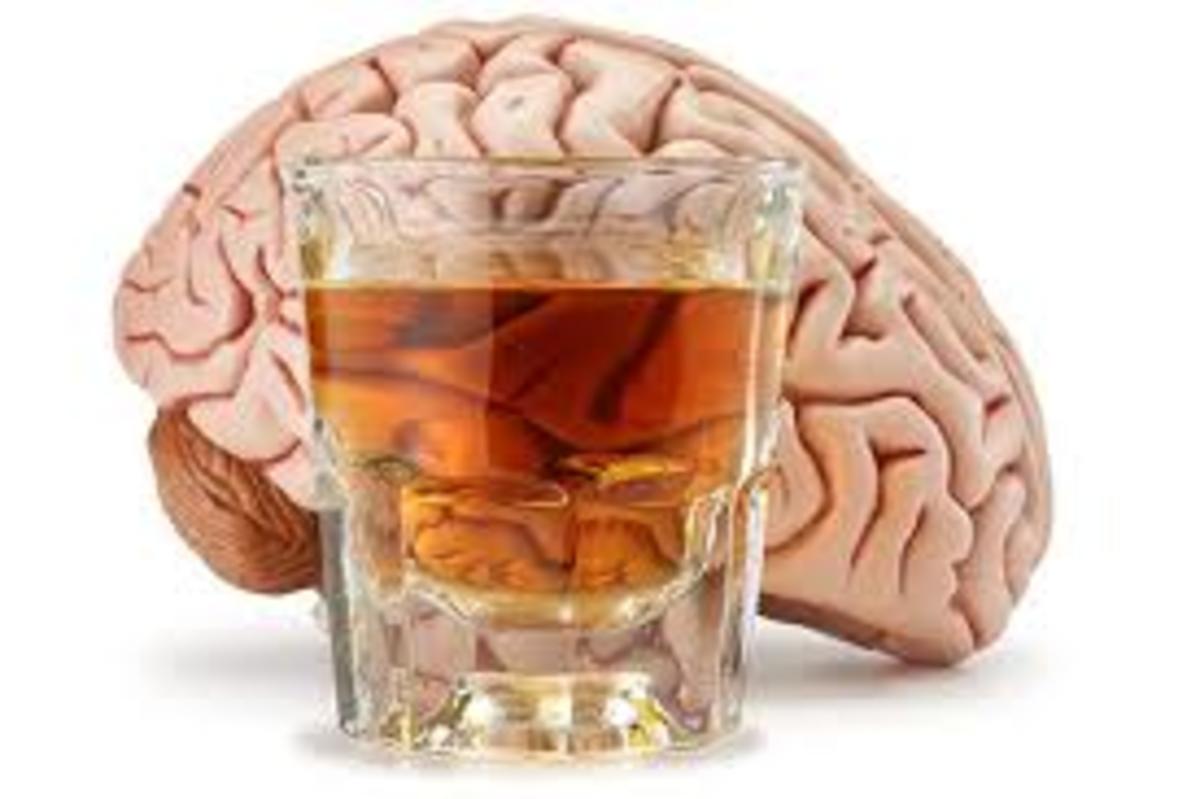- HubPages»
- Health»
- Mental Health»
- Addiction»
- Alcoholism
The Course of Alcohol

General Description
Ethanol, or ethyl alcohol, also simply known as alcohol is a psychoactive drug that is typically used recreationally. Alcohol comes in the form of a liquid or a beverage; and is known to affect the brain as well as behaviors. Such beverages known to contain alcohol are beers, ales, wines, and hard liquors (Advokat, 2014). Depending on which beverage one chooses to drink there is a different amount of alcohol present. Beer typically contains about 5 percent of alcohol, but can be as much as 10%, while, wine tends to have between 12-15 percent, and liquor contains 40-50 percent of alcohol (Advokat, 2014).
Neuronal Aspects
Though the neuronal effects of alcohol are vague, it is observed that alcohol implies depressant behavioral effects (Advokat, 2014). Alcohol acts as an inhibitor to the glutamate receptors. The glutamate receptors work within the hippocampus, amygdala, and striatum; and are responsible for motor performance and memory. Alcohol is known to suppress the glutamate receptors thus also inhibiting the gamma-aminobutyric (GABA) acid neurotransmitter system. According to Adams (2017) the neurotransmitter GABA and excitatory neurotransmitter N-methyl-D- aspartate (NMDA) are inhibited due to an imbalance due to exposure of alcohol. The GABA neurotransmitter systems are responsible for memory, cognitive, and motor performances, therefore it would be assumed that alcohol would have an impact on their synaptic activity. Short-term, alcohol stimulates and increases the chloride ions in the GABA system, and suppresses NMDA; (Adams, 2017); causing inhibition to certain functions. Inhibition causes sedation, muscle relaxation, and cognitive and motor skill impairment (Advokat, 2014). There is even speculation that serotonin receptors are responsible in the feeling of alcohol reward, and increasing the craving and dependence on the substance. Advokat (2014) claims serotonin receptors are involved in the idea of addictions and relapse.

Mechanism and Metabolizing
Since alcohol is a recreational beverage, therefore it is orally ingested. It is easily diffused across all membranes, thus quickly and entirely absorbed by the gastrointestinal (GI) tract (Advokat, 2014). It can take anywhere from 15minutes to one hour for the alcohol to reach its maximum blood levels; the time of absorption, the rate, as well as where in the GI tract does depend on the how full the individual’s stomach is at the point of ingestion. If a person drinks while having a full stomach much of the alcohol will remain in the stomach and will be metabolized right there therefore leading to less alcohol entering the blood stream. However, if a person drinks on an empty stomach the alcohol will not be absorbed by the food but rather through the body, leading to higher blood-alcohol content. Alcohol differs from many other drugs as it is distributed evenly though out the entire body’s tissues and fluid; also freely flowing through the blood-brain barrier at a rather rapid rate (Advokat, 2014). It is also important to keep in mind just as it easily flows through the blood-brain barrier; it also freely flows through the placenta and greatly affects the developing brain of the fetus. There is an enzyme called alcohol dehydrogenase (ADH) that metabolizes about 95% of alcohol a person drinks, the remaining 5% is expelled unchanged through the lungs (Advokat,2014). Of the 95% of alcohol that is metabolized 85% is broken down in the liver, while the remaining10% is metabolized in the lining of the stomach (Advokat, 2014). There are three steps to alcohol’s metabolic process that ADH is responsible for: step 1- ADH converts alcohol to acetaldehyde, step 2- ADH then converts acetaldehyde to acetic acid, and finally step 3- the acetic acid is broken down into carbon dioxide and water, and then is released through burning calories (Advokat, 2014). On average of the 100 percent of the ingested alcohol, as person can metabolize up to 10-14 milliliters per hour (Advokat, 2014). Therefore if a person ingests more than 10-14 milliliters of alcohol within an hour their blood levels begin to become more concentrated. The more concentrated the blood the more chances of becoming drunk or impaired due to alcohol.
Differentiated Effects
Alcohol affects men and women differently; with respect to their differences in body weight. Advokat (2014) states women have a higher blood ethanol concentration than men. The reasons for the higher levels are due to the facts that women have lower ADH enzyme levels than men do, therefore they do not metabolize as much or at the same rate. Also, men typically have more muscle than fat as women do. The more muscle there is the more and better the blood flow; with increased amounts of blood, the more diluted the alcohol is. With understanding that fat has little blood flow; in respect to those who have a higher fat content, the alcohol will therefore build and be concentrated in the blood’s plasma therefore leading to higher blood-alcohol rates (Advokat,2014).
Side Effects
The more concentrated with alcohol and individual’s blood is the greater the risks of intoxication. Intoxication is a state of mental and physical impairment that is typically brought on by a drug. Pikirenia (2017) states the general effects of alcohol are lowered concentration, talkativeness, increased communicativeness, poor self-control, and an increase in pain threshold. According to Advokat (2014) alcohol acts sedative therefore impairing functions. Such functions that become impaired are one’s ability to think, react, walk, operate machinery especially that of a motor vehicle. If drinking alcohol is excessive it can cause sever impairment leading to dangerous actions; such as losing control, cannot make logical connections, motor deficits, understanding becomes more limited and memory begins to suffer (Pikirenia, 2017). However since acting as a sedative, if taken in moderation it can aid with relaxation from panic and anxiety. The long-term effects of alcohol can build a tolerance to the drug. This occurs since alcohol induces the ADH in the liver, therefore increasing the rate of metabolism leading to a tolerance for alcohol, and even other drugs that have the same effects as alcohol (Advokat,2014). Along with a tolerance for drug, there is a chance that an addiction can form due to want and possibly the need for the effects of the drug.

Alcohol Abuse
According to Pikirenia (2017) alcohol abuse can cause sever changes in cognitive functioning. It is believed that these changes are cause by the first step in the metabolic process. When alcohol is converted to acetaldehyde (ACD) it effects and influences the mental process. Pikirenia (2017) states ACD elevates drowsiness, amnestic disorders, and interferes with the reward system. Therefore ACD interacts with noradrenaline, serotonin, and endorphins causing stimulation, impairments in perception and a decrease in anxiety (Pikirenia, 2017). When alcohol is abused and taken for an extensive period of time there is a transformation of serotonin to melatonin and it causes wake-sleep cycle impairment (Pikirenia, 2017). When alcohol is abused it is commonly known as Alcohol use disorder (AUD). Adams (2017) states risky alcohol consumption can place individuals in risk of healthy consequences. Rachdaoui (2017) states alcohol abuse can result in abnormalities of important body systems, one such system is the endocrine system. With alcohol already impairing the central nervous system CNS, when it impacts the endocrine system it disrupts organs and cells within the body (Rachdaoui, 2017). Since the endocrine system is responsible for hormone secretion, when it is disrupted by alcohol, hormones are secreted into the blood stream and have a longer-lasting effect (Rachdaoui, 2017). “Alcohol intoxication induces hormonal disturbances that can disrupt the body’s ability to maintain homeostasis and eventually can result in various disorders, such as cardiovascular diseases, reproductive deficits, immune dysfunction, certain cancers, bone disease, and psychological and behavioral disorders” (Rachdaoui, p. e-1. 2017). Adams (2017) explains risky alcohol consumption as the intake of up to 14 or more drinks per week also equating to more than 4 drinks per day for males under 65 or 3 drinks per day for females under the age of 65. Those who consume alcohol at the risky consumption rate are more inclined to develop AUD. In cases of alcohol abuse, many can suffer from alcohol withdrawal syndrome (AWS). AWS occurs when a person stops drinking alcohol after a period of excessive, heavy or chromic ingestion (Adams, 2017). Those with AWS are often rather ill and tend to be admitted to intensive care units within hospitals (Adams, 2017).
References
Adams, B. (2017) Pharmacologic Management of Alcohol Withdrawal Syndrome in Intensive Care units. AACN Advanced Critical Care. 28(3). 233-238.
Advokat, C. D., Comaty, J. E., & Julien, R. M. (2014). Julien's primer of drug action: A comprehensive guide to the actions, uses, and side effects of psychoactive drugs (13th Ed.). New York, NY: Worth Publishers.
Pikirenia, U. (2017) Cognitive impairment due to alcohol abuse: current status of research. Vestnik Sankt-Peterburgskogo Universiteta, Seriia 11: Medicina. 12(3). 266-272.
Rachdaou, N. (2017). Pathophysiology of the effects of alcohol abuse on the endocrine system. Alcohol research: current reviews. 38(2). 1-22.
© 2018 Kristina







